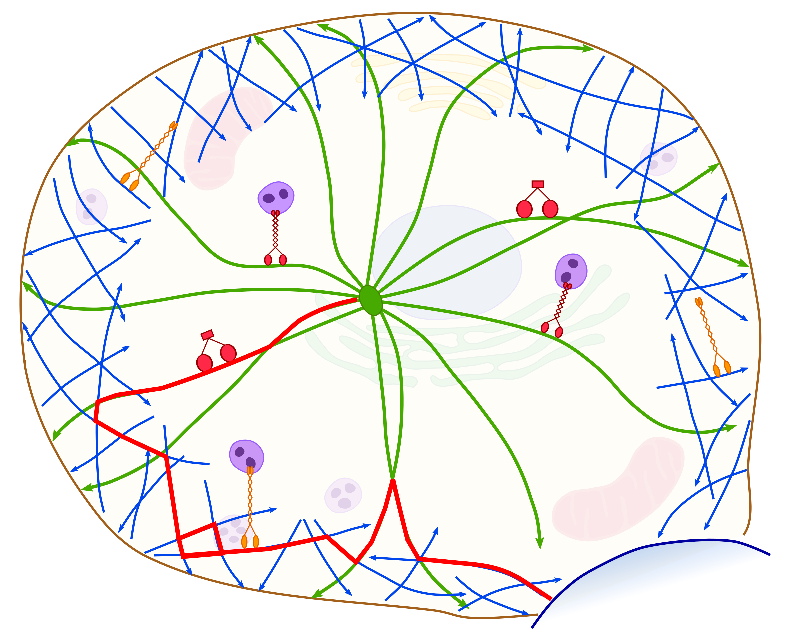AG — Prof. Heiko Rieger — Statistical Physics
Spatial cytoskeleton organization supports targeted intracellular transport

The accurate delivery of various cargoes is vital for maintaining the correct function of cells and organisms. Cargo, such as proteins, vesicles, organelles etc., is transferred to specific target destinations via molecular motor assisted transport along cytoskeletal filaments. The transport efficiency is strongly affected by the spatial organization of the cytoskeleton network, which is generally very inhomogeneous. In cells with a centrosome microtubules grow radially from the central microtubule organizing center towards the cell periphery whereas actin filaments form a dense meshwork, the actin cortex, underneath the cell membrane with a broad range of orientations. The emerging ballistic motion along filaments is frequently interrupted due to constricting intersection nodes or cycles of detachment and reattachment processes in the crowded cytoplasm. A prominent example of targeted intracellular search can be found in Cytotoxic T Lymphocytes (CTL) which play a key role in immune response and defeat tumorigenic or virus-infected cells. When in contact with a pathological cell, CTL form a close connection to it, which is called immunological synapse. Toxic material is then actively transported and exclusively released at the synapse.
The description of intracellular transport is a challenging theoretical task as it comprises an intricate interplay between motor performance and spatial organization of the cytoskeleton. We still lack precise knowledge about how cells adapt to various transport tasks.
In order to investigate the efficiency of search strategies established by the cell we formulate a random velocity model with intermittent arrest states. We evaluate efficiency in terms of mean first passage times for three paradigmatic intracellular transport tasks: i) the narrow escape problem which emerges during transport to a synapse or other specific region on the membrane of a cell, ii) the reaction problem which considers the binding time of two particles within the cell and iii) the reaction-escape scenario which arises when cargo must be released at a synapse only after paring with another particle. With extensive computer simulations we analyze the dependence of the search efficiency on the structural characteristics of the cytoskeleton, the motor properties and the fraction of time spent in each state of motility.
Our results indicate that the confinement of randomly oriented cytoskeleton filaments to a thin actin cortex is not a handicap for the cell, but can actually, in conjunction with radial transport along microtubules, substantially increase the efficiency of various transport tasks. Remarkably, the optimal width of the actin cortex is in good agreement to biological data. Thus, our work outlines that a thin actin cortex, besides its advantages concerning cell stability or motility, also serves as an efficient key to intracellular search problems.
References
| Spatial organization of the cytoskeleton enhances cargo delivery to specific target areas on the plasma membrane of spherical cells |
|
| Phys. Biol. 13, 066003 (2016) | [pdf], [arXiv] |
| Spatial cytoskeleton organization supports targeted intracellular transport |
|
| Biophys. J. 114, 1420 (2018) | [pdf], [arXiv] |
Legal notice (Impressum) Privacy policy



